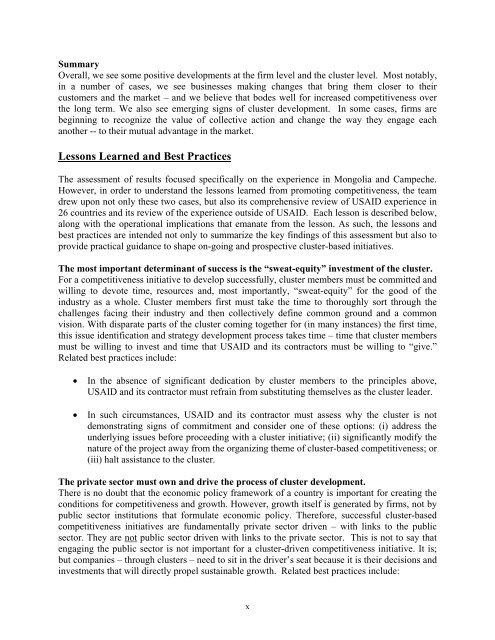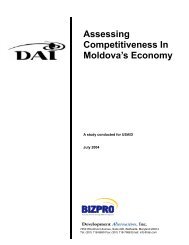Promoting Competitiveness in Practice - Economic Growth - usaid
Promoting Competitiveness in Practice - Economic Growth - usaid
Promoting Competitiveness in Practice - Economic Growth - usaid
You also want an ePaper? Increase the reach of your titles
YUMPU automatically turns print PDFs into web optimized ePapers that Google loves.
Summary<br />
Overall, we see some positive developments at the firm level and the cluster level. Most notably,<br />
<strong>in</strong> a number of cases, we see bus<strong>in</strong>esses mak<strong>in</strong>g changes that br<strong>in</strong>g them closer to their<br />
customers and the market – and we believe that bodes well for <strong>in</strong>creased competitiveness over<br />
the long term. We also see emerg<strong>in</strong>g signs of cluster development. In some cases, firms are<br />
beg<strong>in</strong>n<strong>in</strong>g to recognize the value of collective action and change the way they engage each<br />
another -- to their mutual advantage <strong>in</strong> the market.<br />
Lessons Learned and Best <strong>Practice</strong>s<br />
The assessment of results focused specifically on the experience <strong>in</strong> Mongolia and Campeche.<br />
However, <strong>in</strong> order to understand the lessons learned from promot<strong>in</strong>g competitiveness, the team<br />
drew upon not only these two cases, but also its comprehensive review of USAID experience <strong>in</strong><br />
26 countries and its review of the experience outside of USAID. Each lesson is described below,<br />
along with the operational implications that emanate from the lesson. As such, the lessons and<br />
best practices are <strong>in</strong>tended not only to summarize the key f<strong>in</strong>d<strong>in</strong>gs of this assessment but also to<br />
provide practical guidance to shape on-go<strong>in</strong>g and prospective cluster-based <strong>in</strong>itiatives.<br />
The most important determ<strong>in</strong>ant of success is the “sweat-equity” <strong>in</strong>vestment of the cluster.<br />
For a competitiveness <strong>in</strong>itiative to develop successfully, cluster members must be committed and<br />
will<strong>in</strong>g to devote time, resources and, most importantly, “sweat-equity” for the good of the<br />
<strong>in</strong>dustry as a whole. Cluster members first must take the time to thoroughly sort through the<br />
challenges fac<strong>in</strong>g their <strong>in</strong>dustry and then collectively def<strong>in</strong>e common ground and a common<br />
vision. With disparate parts of the cluster com<strong>in</strong>g together for (<strong>in</strong> many <strong>in</strong>stances) the first time,<br />
this issue identification and strategy development process takes time – time that cluster members<br />
must be will<strong>in</strong>g to <strong>in</strong>vest and time that USAID and its contractors must be will<strong>in</strong>g to “give.”<br />
Related best practices <strong>in</strong>clude:<br />
• In the absence of significant dedication by cluster members to the pr<strong>in</strong>ciples above,<br />
USAID and its contractor must refra<strong>in</strong> from substitut<strong>in</strong>g themselves as the cluster leader.<br />
• In such circumstances, USAID and its contractor must assess why the cluster is not<br />
demonstrat<strong>in</strong>g signs of commitment and consider one of these options: (i) address the<br />
underly<strong>in</strong>g issues before proceed<strong>in</strong>g with a cluster <strong>in</strong>itiative; (ii) significantly modify the<br />
nature of the project away from the organiz<strong>in</strong>g theme of cluster-based competitiveness; or<br />
(iii) halt assistance to the cluster.<br />
The private sector must own and drive the process of cluster development.<br />
There is no doubt that the economic policy framework of a country is important for creat<strong>in</strong>g the<br />
conditions for competitiveness and growth. However, growth itself is generated by firms, not by<br />
public sector <strong>in</strong>stitutions that formulate economic policy. Therefore, successful cluster-based<br />
competitiveness <strong>in</strong>itiatives are fundamentally private sector driven – with l<strong>in</strong>ks to the public<br />
sector. They are not public sector driven with l<strong>in</strong>ks to the private sector. This is not to say that<br />
engag<strong>in</strong>g the public sector is not important for a cluster-driven competitiveness <strong>in</strong>itiative. It is;<br />
but companies – through clusters – need to sit <strong>in</strong> the driver’s seat because it is their decisions and<br />
<strong>in</strong>vestments that will directly propel susta<strong>in</strong>able growth. Related best practices <strong>in</strong>clude:<br />
x
















